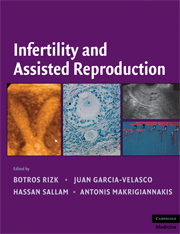Book contents
- Frontmatter
- Contents
- Contributors
- Foreword
- Preface
- Introduction
- PART I PHYSIOLOGY OF REPRODUCTION
- PART II INFERTILITY EVALUATION AND TREATMENT
- PART III ASSISTED REPRODUCTION
- PART IV ETHICAL DILEMMAS IN FERTILITY AND ASSISTED REPRODUCTION
- 69 Stem Cell Research
- 70 Fertility Preservation in Female and Male Cancer Patients
- 71 Ethical Dilemmas in ART: Current Issues
- 72 Infertility Treatment in Perimenopausal Women: Ethical Considerations
- 73 Religious Perspectives of Ethical Issues in Inferility and ART
- 74 The Future of Assisted Reproduction
- Index
- Plate section
- References
71 - Ethical Dilemmas in ART: Current Issues
from PART IV - ETHICAL DILEMMAS IN FERTILITY AND ASSISTED REPRODUCTION
Published online by Cambridge University Press: 04 August 2010
- Frontmatter
- Contents
- Contributors
- Foreword
- Preface
- Introduction
- PART I PHYSIOLOGY OF REPRODUCTION
- PART II INFERTILITY EVALUATION AND TREATMENT
- PART III ASSISTED REPRODUCTION
- PART IV ETHICAL DILEMMAS IN FERTILITY AND ASSISTED REPRODUCTION
- 69 Stem Cell Research
- 70 Fertility Preservation in Female and Male Cancer Patients
- 71 Ethical Dilemmas in ART: Current Issues
- 72 Infertility Treatment in Perimenopausal Women: Ethical Considerations
- 73 Religious Perspectives of Ethical Issues in Inferility and ART
- 74 The Future of Assisted Reproduction
- Index
- Plate section
- References
Summary
Most treatments in assisted reproduction raise ethical issues, and it is difficult to be exhaustive and detailed. Nevertheless, the aim of this chapter was to highlight the main ethical concerns that have been discussed since the inception of the complex, although now routine, technique of IVF. That the human embryo could be observed outside the body captured the world's imagination, in a different way than, for instance, the less technically taxing but older techniques of sperm donation. This had also led to many debates, and so do eternal themes, which return only because of the use of more modern technology like social sex selection. This chapter will cover gametes donation for reproduction and research, including embryo research and the newer issues around stem cell research, a subject of major current interest, rekindled by the therapeutic hopes from the possible use of embryonic stem cells, with or without somatic cell nuclear transfer technology (SCNT). Furthermore, the complex choices to be made in the use of preimplantation genetic diagnosis (1) are also the matter for ethical debate, and finally, one should not avoid the international concerns about sex selection for social reasons, an issue that has implications far outside the specialist field of ART. Other more specialized issues, from the cryopreservation of reproductive tissues (2) to the use of posthumous gametes (3), have been included in previous publications.
Keywords
- Type
- Chapter
- Information
- Infertility and Assisted Reproduction , pp. 717 - 722Publisher: Cambridge University PressPrint publication year: 2008



